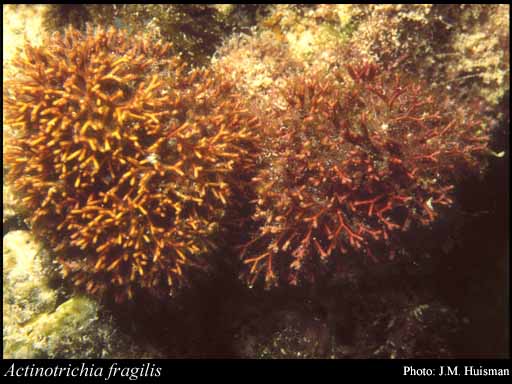- Reference
- Dansk Bot.Ark. 8:6, Pl. 1, Fig. 4 (1932)
- Conservation Code
- Not threatened
- Naturalised Status
- Native to Western Australia
- Name Status
- Current

Scientific Description
Habit and structure. Thallus to 7 cm high, grey-pink to orange-red, forming a hemispherical or spreading clump, subdichotomously branched at intervals of 2–10 mm. Axes 250–600 µm in diameter; emergent filaments either absent, randomly arranged, or in whorls at intervals of 150–200 µm. Medullary filaments 5–12 µm in diameter. Cortex 3 or 4 cells thick; inner cells 22–32 µm in diameter, with occasional lateral fusions; epidermal cells turbinate, 20–27 µm in diameter; emergent filaments cylindrical, to 550 µm long, with cells 10–13 µm in diameter.
Reproduction. Spermatangial cavities 150–250 µm in diameter; spermatangia spherical to obovoid, c. 5 × 7 µm. Cystocarps not observed. Tetrasporangia subspherical, 25–27 × 22–25 µm.
Distribution. Known from Coral Bay, W.Aust., presumably across northern Australia to the Great Barrier Reef, Qld. Widespread in tropical seas.
Habitat. A. fragilis growson rock or coral platforms in the subtidal.
Distribution
- IBRA Regions
- Carnarvon, Dampierland, Northern Kimberley.
- IBRA Subregions
- Cape Range, Mitchell, Pindanland.
- IMCRA Regions
- Kimberley, Ningaloo, Pilbara (offshore).
- Local Government Areas (LGAs)
- Ashburton, Broome, Carnarvon, Derby-West Kimberley, Exmouth, Karratha, Wyndham-East Kimberley.